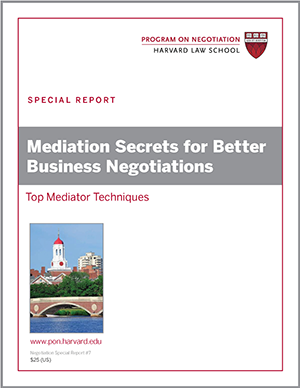
Group negotiations are a fact of managerial life, yet the outcomes of teamwork are highly unpredictable. Sometimes groups cohere, reaching novel solutions to nagging problems, and sometimes infighting causes them to collapse. How can you predict when conflict will emerge in groups, and what can you do to stop it?
Dora Lau of the Chinese University of Hong Kong and Keith Murnighan of the Kellogg Graduate School of Management at Northwestern University have examined group conflict in terms of faultlines—the cracks that result when groups split into homogeneous subgroups according to demographic characteristics.
How Factions Impact Multi-party Group Negotiation Scenarios
For instance, in a four-person negotiation role play simulation group made up of two white males in their forties and two African-American females in their twenties, a very strong faultline would exist, one clearly defined by age, gender, and race. In a bargaining team consisting of one white male, one Asian male, one Hispanic female, and one African-American female, all in their thirties, faultlines would be less evident.
How Faultlines Inform Multiparty Negotiation Dynamics
Katerina Bezrukova of Rutgers University and her colleagues compared the effects of faultlines based on social categories (e.g., age, race, or gender) with those based on information (e.g., education or work experience). They found that groups with strong information-based faultlines perform better than groups with strong demographic-based faultlines. While the latter create dysfunctional conflict within the group, information-based faultlines provide the diversity of information needed for effective performance—in other words, they provide functional conflict.
These negotiation research studies provide useful hints on how diversity can be effectively managed. Specifically, when forming teams, avoid obvious demographic faultlines that would allow group members to split into categories.
Conclusion?
When broader diversity exists, faultlines can simply disappear.
Related Negotiation Skills Article: Negotiation Examples in Business: Putting Your Negotiated Agreement Into Action – How do negotiators move beyond the negotiation table and implement their negotiated agreement? A different set of skills closely related to negotiation may be necessary, and these include the ability to build a relationship with your counterpart as well as being able to still find areas for value creation and collaboration. Thus, in many ways, negotiations continue long after the negotiated agreement has been signed. Learn how to shape your relationship with your bargaining counterpart and find ways to create and claim value long after decisions were made at the bargaining table.
Adapted from “Faultlines in Group Negotiation,” first published in the Negotiation newsletter.
Originally published in 2010.





No Responses to “Managing Faultlines in Group Negotiations”